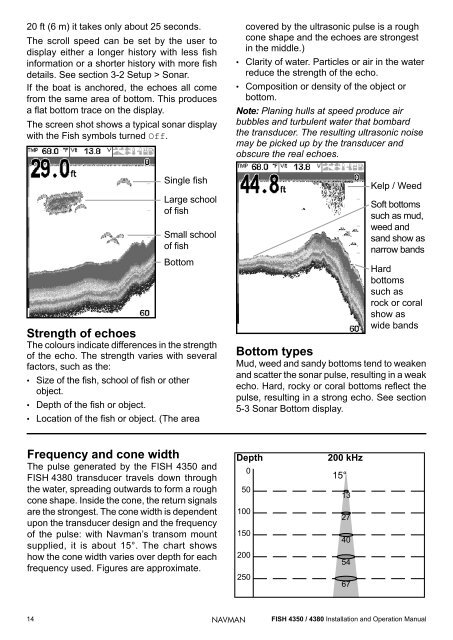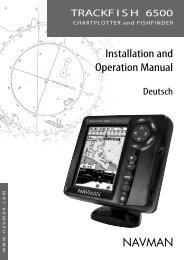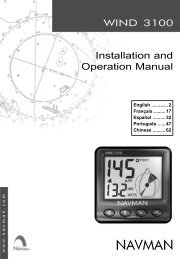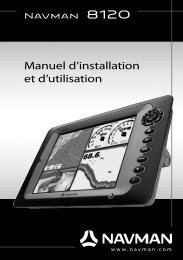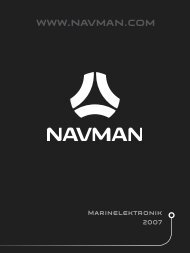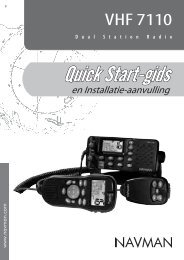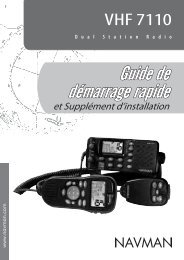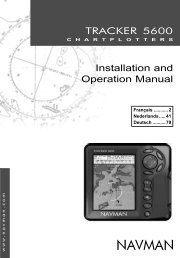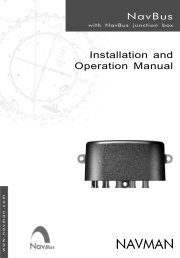English - Navman Marine
English - Navman Marine
English - Navman Marine
You also want an ePaper? Increase the reach of your titles
YUMPU automatically turns print PDFs into web optimized ePapers that Google loves.
20 ft (6 m) it takes only about 25 seconds.<br />
The scroll speed can be set by the user to<br />
display either a longer history with less Þ sh<br />
information or a shorter history with more Þsh<br />
details. See section 3-2 Setup > Sonar.<br />
If the boat is anchored, the echoes all come<br />
from the same area of bottom. This produces<br />
a ß at bottom trace on the display.<br />
The screen shot shows a typical sonar display<br />
with the Fish symbols turned Off.<br />
covered by the ultrasonic pulse is a rough<br />
cone shape and the echoes are strongest<br />
in the middle.)<br />
• Clarity of water. Particles or air in the water<br />
reduce the strength of the echo.<br />
• Composition or density of the object or<br />
bottom.<br />
Note: Planing hulls at speed produce air<br />
bubbles and turbulent water that bombard<br />
the transducer. The resulting ultrasonic noise<br />
may be picked up by the transducer and<br />
obscure the real echoes.<br />
Single Þ sh<br />
Large school<br />
of Þsh<br />
Small school<br />
of Þsh<br />
Bottom<br />
Strength of echoes<br />
The colours indicate differences in the strength<br />
of the echo. The strength varies with several<br />
factors, such as the:<br />
• Size of the Þsh, school of Þsh or other<br />
object.<br />
• Depth of the Þ sh or object.<br />
• Location of the Þ sh or object. (The area<br />
Kelp / Weed<br />
Soft bottoms<br />
such as mud,<br />
weed and<br />
sand show as<br />
narrow bands<br />
Hard<br />
bottoms<br />
such as<br />
rock or coral<br />
show as<br />
wide bands<br />
Bottom types<br />
Mud, weed and sandy bottoms tend to weaken<br />
and scatter the sonar pulse, resulting in a weak<br />
echo. Hard, rocky or coral bottoms reß ect the<br />
pulse, resulting in a strong echo. See section<br />
5-3 Sonar Bottom display.<br />
Frequency and cone width<br />
The pulse generated by the FISH 4350 and<br />
FISH 4380 transducer travels down through<br />
the water, spreading outwards to form a rough<br />
cone shape. Inside the cone, the return signals<br />
are the strongest. The cone width is dependent<br />
upon the transducer design and the frequency<br />
of the pulse: with <strong>Navman</strong>’s transom mount<br />
supplied, it is about 15°. The chart shows<br />
how the cone width varies over depth for each<br />
frequency used. Figures are approximate.<br />
Depth<br />
0<br />
50<br />
100<br />
150<br />
200<br />
250<br />
200 kHz<br />
15°<br />
13<br />
27<br />
40<br />
54<br />
67<br />
14 NAVMAN<br />
FISH 4350 / 4380 Installation and Operation Manual


